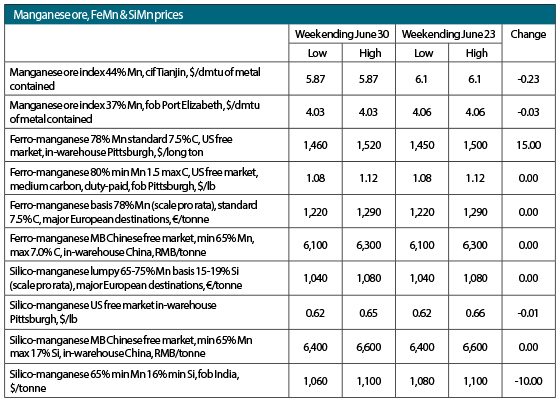- Ore prices under pressure amid dwindling confidence
- Chinese alloys stabilise after mills raise bid prices on improved sentiment
- European market slows due to quarterly negotiations
- US high-carbon ferro-manganese prices elevated amid continued tightness
Ore prices remain under pressure
Manganese ore prices remained under pressure last week, with prices for both grades dropping on limited sales and as stock holders lost confidence ahead of the summer period.
The Metal Bulletin 37% index fell 3 cents to $4.03 per dmtu fob Port Elizabeth last week, while the 44% index, cif Tianjin, declined 23 cents to $5.87 per dmtu.
Prices had rallied between March and early June, when Chinese traders bought and held stocks, while Indian buyers restocked. As prices climbed, some had said a similar rally to that seen at the end of 2016 could be imminent, when prices skyrocketing to above $9 per dmtu cif Tianjin for 44%.
Since then, though, weakness has entered the market, and some stockholders have lost confidence.
“There are two types of stock holder in China,” one market source said.
“One group is liquidating. The others are refusing. But gradually, there’s a slow panic spreading,” he added.
He noted that prices in Chinese ports have been coming off quickly ahead of dollar prices.
“I only expected a slow-down in mid-July to August. Not this soon. But India has stopped stocking up, so material isn’t being diverted so much anymore,” he said.
Others were of the belief that a serious panic had not set in, however.
“The market will stay relatively ‘softish’. But demand is still good. It’s just not as much as three-months ago,” a second source said.
Port offers from traders on high grade ores like Australian lump were at 50-52 yuan per dmtu and South African semi-carbonate lump was traded at 35-37 yuan per dmtu on June 30, according to sources in China.
Most buyers in China kept on the sidelines last week, waiting to see how miners would set their offer for the next round delivery.
Chinese alloy prices find stability after mills raise bid prices
Although port manganese ore prices in China remained weak last week, sentiment in the alloys market improved slightly after mills raised their bid prices.
Metal Bulletin assessed the domestic Chinese silico-manganese price at 6,400-6,600 yuan ($943-972) per tonne on June 30, unchanged from last week. Chinese ferro-manganese prices were similarly flat, holding firm at 6,100-6,300 yuan per tonne.
The most-traded September contact of silico-manganese on the Zhengzhou Commodity Exchange (ZCE) closed at 6,358 yuan per tonne on June 30, up from 6,130 yuan per tonne a week earlier.
Major Chinese steel mills, including Hesteel (Hebei Iron and Steel), announced their July silico-manganese purchase prices last week. Hesteel had initially set a bid of 6,700 yuan per tonne before raising this to 6,750 yuan per tonne, including delivery, amid a recovery in the rebar market which would require more raw materials, allowing smelters to raise their offers on silico-manganese.
However, the price continues to trail the mill’s June purchase price of 7,200 yuan per tonne, including delivery.
European alloys flatten amid quarterly negotiations
Manganese alloy prices were stable in Europe last week, as talk focussed on third quarter contracts and spot activity dwindled.
European ferro-manganese (78% manganese; 7.5% carbon) prices held firm at €1,220-1,290 ($1,389-1,469).
Most sources were focussed on discussions for quarterly shipments, which have been commanding a slight discount in some cases to spot cargoes, sources said.
‘“It’s down slightly for [the third quarter],” one trader said.
“It’s around $1,200-1,275, but no move on spot,” he added.
Another source concurred that little movement had taken place, but argued that the upper end of the range, at $1,290 was no longer achievable in light of the lack of spot demand.
Business was concluded at around €1,220.
Silico-manganese prices, meanwhile, held at €1,040-1,080 per tonne.
“Silico-manganese has also been quiet,” explained one producer.
Similarly, to ferro-manganese, all eyes were on quarterly discussions, as opposed to spot.
But in India, slight weakness continued with prices dipping on the low end to $1,060-1,100 per tonne fob (65:16 silicon), down from $1,080-1,100 a week earlier.
Indian prices have been heavily influenced by the manganese ore weakness.
US ferro-manganese market continues to strengthen
The US high-carbon ferro-manganese market continued to be bolstered by limited inventories within the country.
US spot prices for high-carbon ferro-manganese ascended to $1,460-1,520 per long ton on June 29, up 1.02% from $1,450-1,500 per long ton in the previous week, according to Metal Bulletin sister publication AMM’s latest assessment.
Market participants continue to describe the market as tight, as suppliers have been able to continuously elevate offering prices in recent weeks.
“The high-carbon ferro-manganese market remains extremely tight on supply,” a US supplier source said. “I just don’t see anyone with much extra volume, and demand has been pretty decent.”
“There is no question that it’s still extremely short here,” a second US supplier source agreed.
Given the current supply situation, market participants expected these elevated prices had staying power.
“There is really no clear indication that we are going to see any tailing off of price in the near term, or even by the fourth quarter,” a third US supplier source said.
Meanwhile, silico-manganese prices slipped to 62-65 cents per lb June 29, down 1 cent on the high end from 62-66 per lb on June 22, according to AMM’s latest assessment.
Prices have slipped in recent weeks while market participants worked through quarterly and second half negotiations.
Forward enquiries for the fourth quarter in particular have been garnering more aggressive prices.
“The market is tight on the front end, but on the back end it is a little looser,” a US supplier source said.
Given the cheaper prices overseas, prices are expected to fall closer in line with global pricing as lower cost inventory arrives.
“It is not to be unexpected to see prices narrow in terms of where they are outside of the USA,” the supplier source added.

